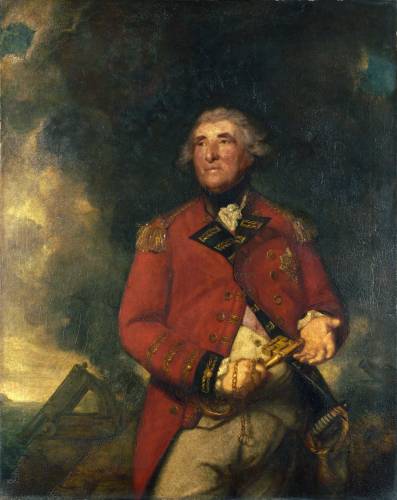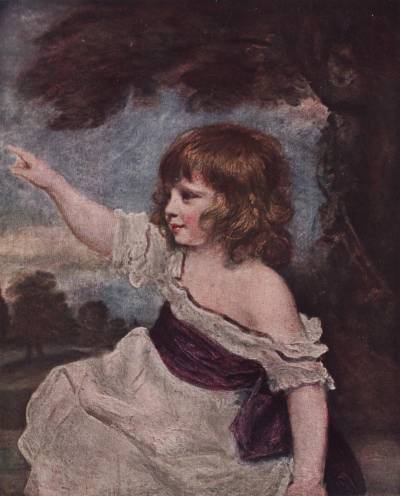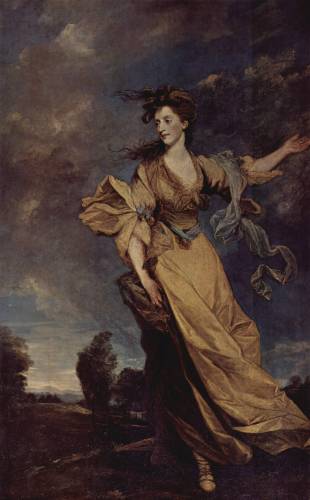აბაშის ხმა
Каталог статей
| მთავარი » სტატიები » Мировая Живопись » British painting |
Sir Joshua Reynolds
Sir Joshua Reynolds(1723-1792) To feel to the full the contrast between Reynolds and Hodarth, there is no better way than to look at their self-portraits. Hogarth's of 1745 in the Tate Gallery, Reynolds's of 1773 in the Royal Academy. Hogarth had a round face, with sensuous lips, and in his pictures looks you straight in face. He is accompanied by a pug-dog licking his lip and looking very much like his master. The dog sits in front of the painted oval frame in which the portrait appears--that is the Baroque trick of a picture within a picture. Reynolds scorns suck tricks. His official self-portrait shows him in an elegant pose with his glove in his hand, the body fitting nicely into the noble triangular outline which Raphael and Titian had favoured, and behind him on the right appears a bust of Michelangelo. This portrait is clearly as programmatic as Hogarth's. Reynolds's promramme is known to us in the greatest detail. He gave altogether fifteen discourses to the students of the Academy, and they were all printed. And whereas Hogarth's Analysis of Beaty was admired by few and neglected by most--Reynolds's Discourses were international reading.  What did Reynolds plead for? His is on the whole a con sistent theory. "Study the great masters...who have stood the test of ages, " and especially "study the works to notice"; for "it is by being conversant with the invention of others that we learn to invent". Don't be "a mere copier of nature", don't "amuse mankind with the minute neatness of your imitations, endeavour to impress them by the grandeur of [...] ideas". Don't strive for "dazzling elegancies" of brushwork either, form is superior to colour, as idea is to ornament. The history painter is the painter of the highest order; for a subject ought to be "generally interesting". It is his right and duty to "deviate from vulgar and strict historical truth". So Reynolds would not have been tempted by the reporter's attitude to the painting of important con-temporary events. With such views on vulgar truth and general ideas, the portrait painter is ipso facto inferior to the history painter. Genre, and landscape and still life rank even lower. The student ought to keep his "principal attention fixed upon the higher excellencies. If you compass them, and compass nothing more, you are still first, class... You may be very imperfect, but still you are an imperfect artist of the highest order". This is clearly a consistent theory, and it is that of the Italian and even more of the French seventeenth century. There is nothing specifically English in it. But what is eminently English about Reynolds and his Discourses is the contrast between what he preached and what he did. History painting and the Grand Manner, he told the stu-dents, is what they ought to aim at, but he was a portrait painter most exclusively, and an extremely successful one. Reynold's "Mrs Siddons as the Tragic Muse": the Grand Manner Taken Seriously For anyone coming to the painting with a fresh eye the first impression must surely be one of dignity and solem-nity. It is an impression created not only by the pose and bearing of the central figure herself, and her costume, but also by the attitude of her two shadowy attendants, by the arrangement of the figures, and by the colour. The colour must appear as one of the most remarkable features of the painting. To the casual glance the picture seems monochromatic. The dominant tone is a rich golden brown, interrupted only by the creamy areas of the face and arms and by the deep velvety shadows of the background. On closer examination a much greater variety in the colour is appar-ent, but the first impression remains valid for the painting as a unit.  The central figure sits on a thronelike chair. She does not look at the spectator but appearsan deep contemplation; her expression is one of melancholy musing. Her gestures aptly reinforce the meditative air of the head and also contribute to the regal quality of the whole figure. A great pendent cluster of pearls adorns the front of her dress. In the heavy, sweeping draperies that envelop the figure there are no frivolous elements of feminine costume to conflict with the initial effect of solemn grandeur. In the background, dimly seen on either side of the throne, are two attendant figures. One, with lowered head and melancholy expression, holds a bloody dagger; the other, his features contorted into an expression of horror, grasps a cup. Surely these figures speak of violent events. Their presence adds a sinister impression to a picture already eavily charged with grave qualities. At the time the portrait was painted, Sarah Siddons was in her late twenties, but she already.had a soli.d decade of acting experience behind her. She was born in 1755, the daughter of Roger Kemble, manager of an itinerant com-pany of actors. Most of her early acting experience was with her father's company touring through English provincial centres. Her reputation rose so quickly that in 1775, when she was only twenty, she was engaged by Garrick to perform at Drury Lane. But this early London adventure proved premature; she was unsuccessful and retired again to the provincial circuits, acting principally at Bath. She threw her full energies into building her repertory and perfecting her acting technique, with the result that her return to London as a tragic actress in the autumn of 1782, was one of the great sensations of theatre history. Almost overnight she found herself the unquestioned first lady of the British stage, a position she retained for thirty years. The leading intellectuals and statesmen of the day were among her most fervent admirers and were in constant attendance at her performance. Among the intelligentsia who flocked to see the great actress and returned again and again was Sir Joshua Reynolds, the august president of the Royal Academy. He was at the time the most respected painter in England, and he also enjoyed a wide reputation as a theorist on art. Reynolds moved with ease among the great men of his day. Mrs Siddons remarks in her memoirs: "...At his house were assembled all the good, the wise, the talented, the rank and fashion of the age." The painting is in fact a brilliantly successful synthe-sis of images and ideas from a wide variety of sources. The basic notion of representing Mrs Siddons in the guise of the Tragic Muse may well have been suggested to Reynolds by a poem honouring the actress and published early in 1783. The verses themselves are not distinguished, but the title and the poet's initial image of Mrs Siddons enthroned as Melpomene, the muse of tragedy, may have lodged in Reynolds's memory and given the initial direction to his thinking about the portrait. It has long been recognized that in the basic organiza-tion of the picture Reynolds had Michelangelo's prophets and sybils of the Sistine ceiling in mind. Mrs Siddons's pose'recalls that of Isaiah, and of the two attendant figures the one on the left is very closely modelled on the simi-larly placed companion of the prophet Jeremiah. Reynolds's attitude toward this sort of borrowing from the works of other artists may seem a little strange to us today. He thought that great works of art should serve as a school to the students at the Royal Academy: "He, who borrows an idea from an ancient, or even from a modern artist not his contemporary, and so accommodates his own work, that it makes a part of it, with no seam or joining appearing, can hardly be charged with plagiarism: poets practise this kind of borrowing, without reserve. But an artist should not be content with this only; he should enter into a competition with his original, and endeavour to improve what he is appropriating to his own work. Such imitation is ... a perpetual exercise of the mind, a continual invention." From this point of view "The Tragia Muse" is a perfect illustration of Reynolds;s advice to the student. If the arrangement of the figures in the portrait of Mrs Siddons suggests Michelangelo, other aspects of the painting, particularly the colour, the heavy shadow effects, and the actual application of the paint, are totally unlike the work of Michelangelo and suggest instead the paintings of Rembrandt. But the amazing thing is that the finished product is in no sense a pastiche. The disparate elements have all been transformed through Reynolds's own visual imagination and have emerged as a unit in which the relationship of all the parts to one another seems not only correct but inevitable. This in itself is an achievement commanding our admiration. In "The Tragic Muse" Reynolds achieved an air of grandeur and dignity which he and his contemporaries regarded as a prime objective of art and which no other portrait of the day embodied so successfully. | |
| ნანახია: 1315 | |
| სულ კომენტარები: 0 | |
მოგესალმები Гость
შესვლის ფორმა |
|---|
ძებნა |
|---|
მინი-ჩეთი |
|---|
საიტის მეგობრები |
|---|
სტატისტიკა |
|---|
